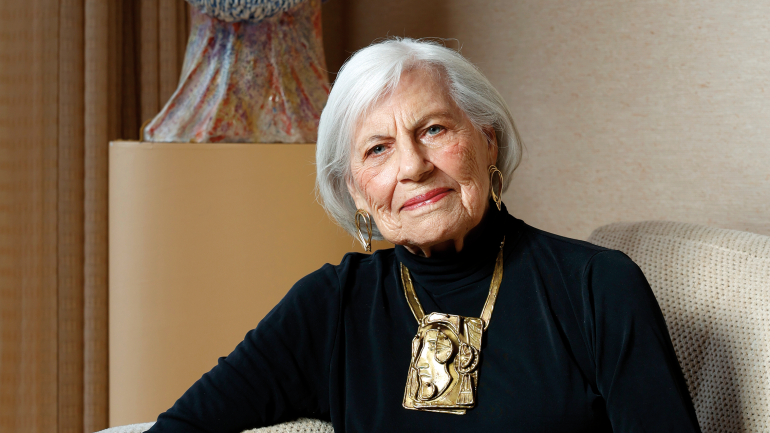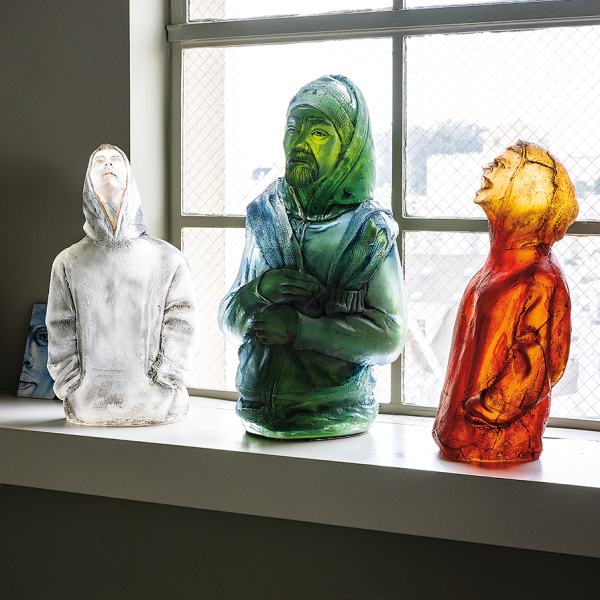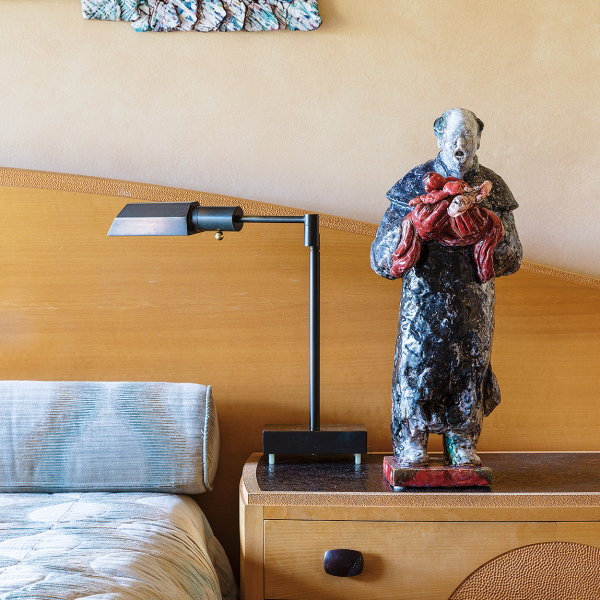The Consummate Collector
The Consummate Collector
Before 1980, Dorothy Saxe had not collected much of anything, apart from some restaurant matchbooks back in her youth.
But soon thereafter, she and her late husband, real estate developer George Saxe, whom she’d met soon after graduating from Northwestern University and who died in 2010, began to amass one of the most thoughtful and free-ranging collections of postwar studio craft in the country—more than 700 objects rendered in glass, ceramic, fiber, metal, and wood, as well as jewelry.
“As a couple, we weren’t very acquisitive—we never cared about buying the latest stuff,” says Dorothy, a petite and commanding woman of 97 who expresses herself in clipped, declarative sentences that are often capped with a dryly humorous coda. “But once we discovered craft, I guess you could say that switch got flipped.”
The Saxes’ passion for collecting was sparked after their three children were grown. Both were immersed in philanthropic pursuits, and weekends found George on the golf course and Dorothy attending opera and ballet. “We wanted something new to us both, so we could learn and enjoy these experiences together—but we didn’t have any idea what that might be,” Dorothy recalls.
When a friend shared her catalog of The Corning Museum of Glass’s 1979 glass exhibition, New Glass: A Worldwide Survey, the genie flew out of the bottle. “We had no inkling there was such a thing as contemporary art glass,” says Dorothy. “We fell in love with the work, and when a glass exhibition came to the Oakland Museum six weeks later, George said, ‘Okay, this is it!’ But we hadn’t a clue where to start.”
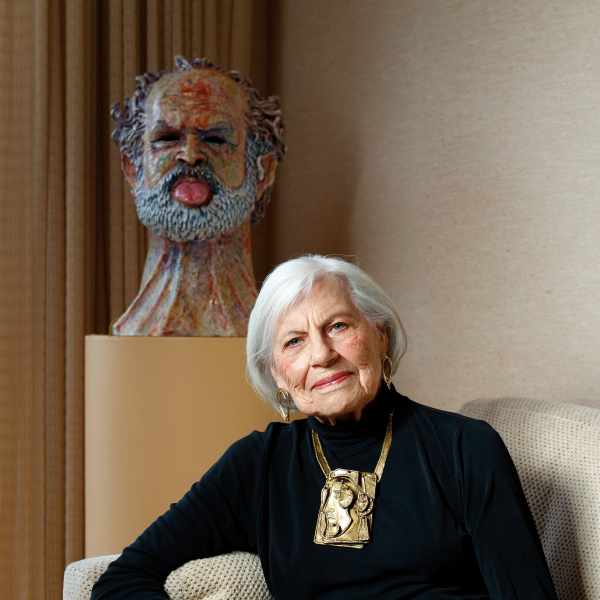
BUST: Robert Arneson, A Hollow Jesture, 1971, glazed ceramic, 20.25 x 12.5 x 14 in.
NECKLACE: Pal and Lumi Kepenyes, untitled necklace, ca. 1985, brass, 11 x 4.5 x 1 in.
Photo courtesy of Craig Lee/The Examiner.
While many in their position might have turned to an art adviser, the Saxes created their own immersion crash course. They paged through the Corning catalog, researched artists, and visited studios and galleries. Above all, they learned to trust their gut—still the best advice Dorothy has for new collectors.
The first pieces they acquired were by Richard Marquis, Jay Musler, “and someone I’ve never heard of before or since,” says Dorothy. “Many of the artists went on to have illustrious careers; others faded away. It made no difference to our enjoyment, because we never bought anything as an investment. An object had to spark an emotional response—literally demand, ‘Take me home with you.’”
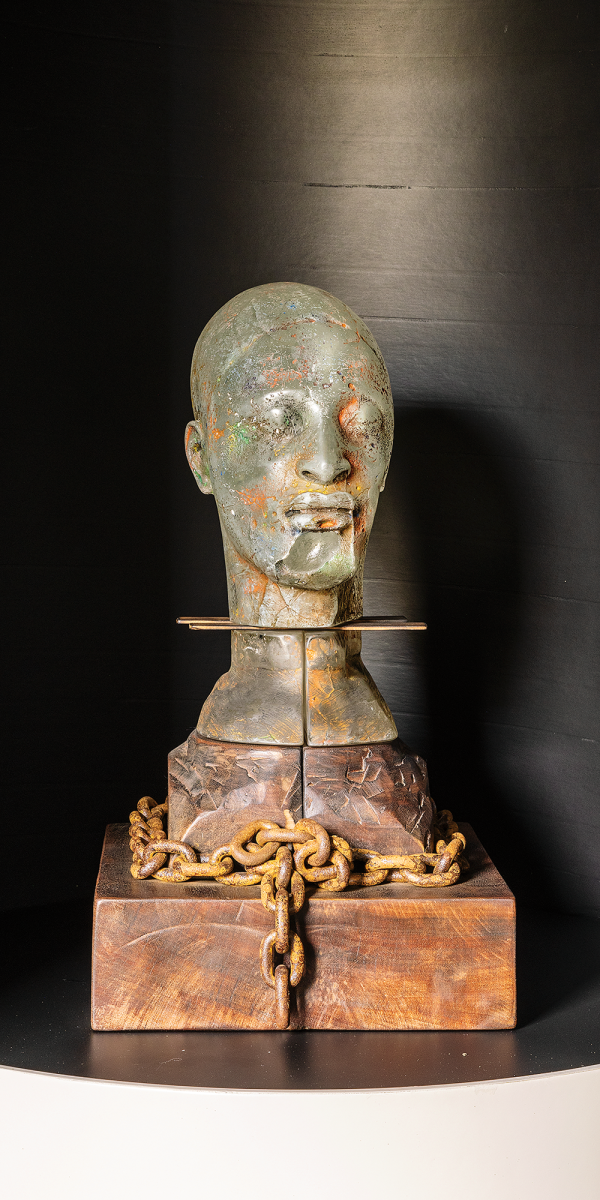
Clifford Rainey, Freedom of Conscience, 1989, glass cast in the lost wax method, cut and acid-etched, oil paint, dividers of wooden rulers, carved wood mount and stand, patinated chain and nails, 23.5 x 13 x 13.25 in. Photo by Alanna Hale.
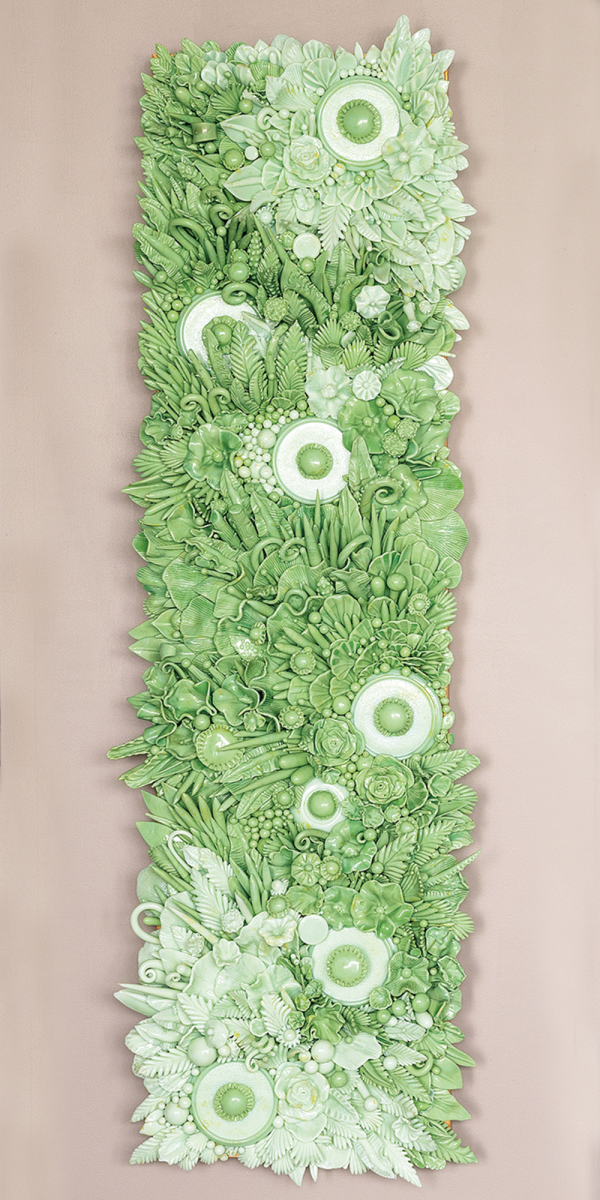
Amber Cowan, River Green & Mint, 2015, flame-worked American pressed glass, mixed media, 52 x 17 x 8 in. Photo by Alanna Hale.
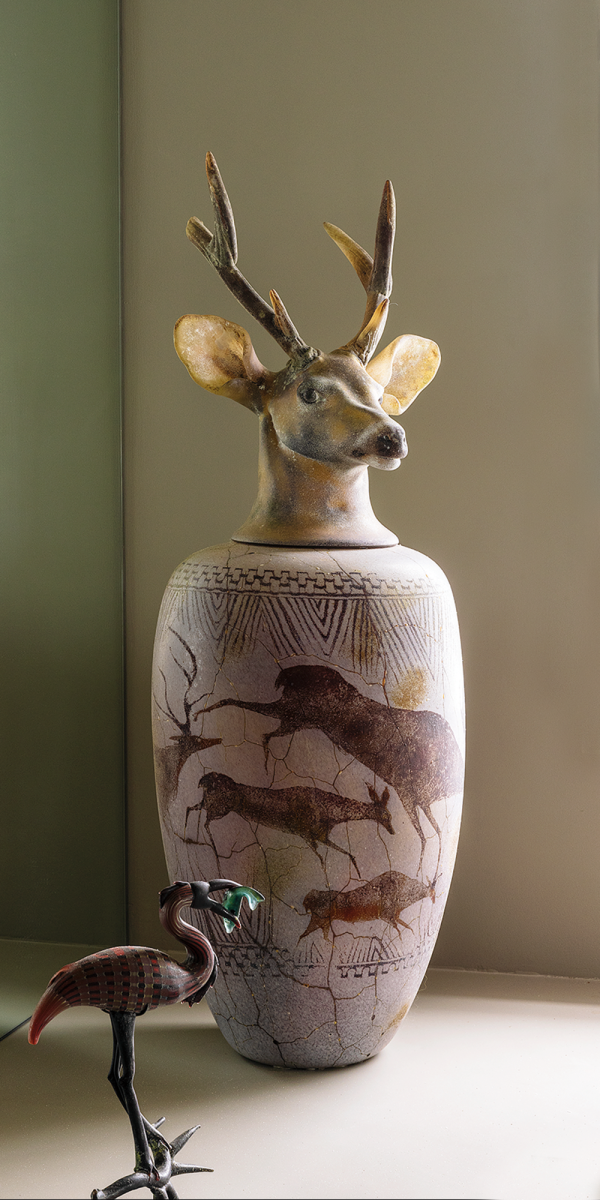
JAR: William Morris, Canopic Jar: Buck, 1993, blown glass, manipulated while hot, 37.75 x 12.5 in (diameter).
BIRD: William Morris, untitled, date unknown, glass, 12 x 8.25 x 4.75 in.
Photo by Alanna Hale.
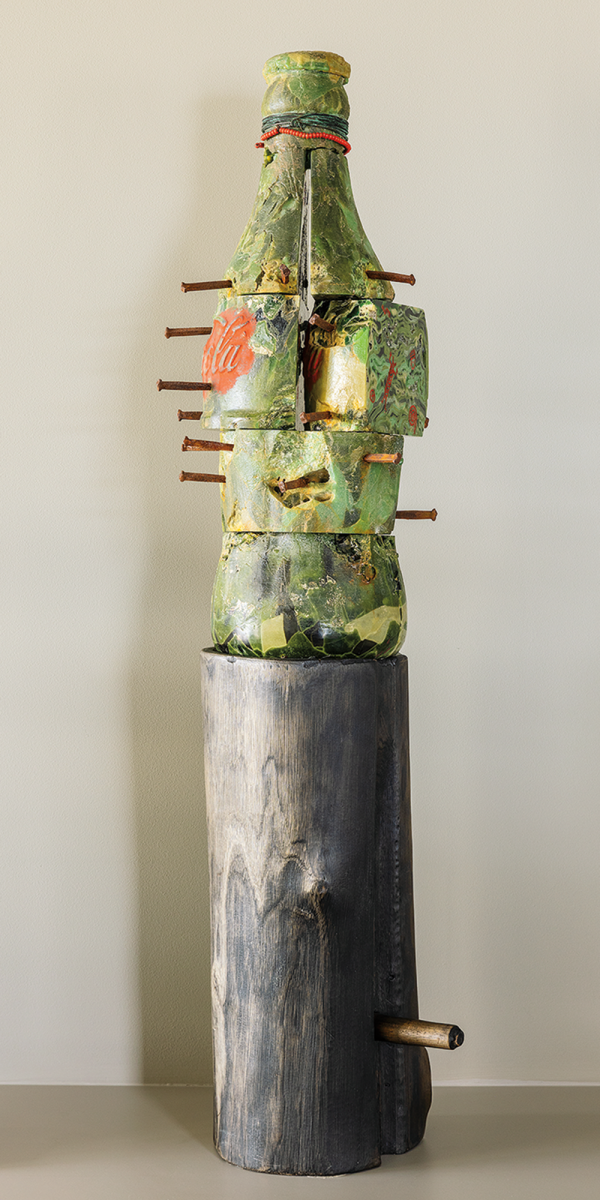
Clifford Rainey, Fetish, 1990, recycled coke bottles cast in the lost wax method, painted, mold-formed inscription of North American Indian symbols from Arizona, iron nails, glass beads, oil paint, beechwood base, 39.5 x 10 x 9.5 in. Photo by Alanna Hale.
This was a siren call they happily heeded, and when their collection of glass outgrew their pied-à-terre in San Francisco, George and Dorothy purchased the apartment next door to gain display space. On a wintry day in November, the objects are animated by the crisp light that pours in through windows facing the whitecap-dotted bay. As Dorothy walks through the rooms (wearing expressive jewelry by Sam Shaw), she rattles off artists’ names and stories as if they’re family members or close friends—which, in fact, many are.
They thought outside the box of established norms of collecting and put together a fantastic collection that not only supported artists but inspired collectors too.
Joey Kirkpatrick, sculptor
“It was the most wonderful time of our lives,” Dorothy reminisces. “The people we met through craft became our best friends—fellow collectors, but especially artists like Howard Ben Tré, Dale Chihuly, Dan Dailey and Linda MacNeil, Flora Mace and Joey Kirkpatrick, and Billy Morris. George gave up golfing, because he said he preferred prowling around the galleries and studios.”
Photo by Alanna Hale.
This sun-dappled space is cozier—more domestic and inward-looking—than their city apartment, and a natural setting for the ceramic, wood, fiber, and metal objects that reside on every surface (a Viola Frey sculpture holds court over the bathtub). The house is, in its way, a shrine to the very values of postwar studio craft: a rejection of the mass-produced and machine-made in favor of the personal and the handwrought.
“At first, the only ceramist we’d heard of was Peter Voulkos,” says Dorothy. “So our dear friend, art dealer Ruth Braunstein, took us to Pete’s studio to pick out a plate. She also showed us some of his stack pieces, and we fell in love with one, but it was way out of our price range for our first foray. Ruth insisted we just enjoy it for a while and then return it. So Pete came over for drinks and placed it in the house—and it was terrific. Every time we tried to return it, Ruth lowered the price—which was not our intention, although it’s a good technique—until finally, we couldn’t afford not to keep it.”
The Voulkos stack was followed, in short order, by ceramists such as Ron Nagle, Richard Shaw, Robert Arneson, Manuel Neri, and Betty Woodman (“her pieces make my heart sing”) and by objects and furniture in other materials—from a John Cederquist trompe l’oeil chest to beaded jewelry by Joyce Scott, a trove of Kay Sekimachi’s delicate fiber vessels, and a wall of turned wood bowls by her late husband, Bob Stocksdale. “Whenever George needed a fix, he’d visit Bob in Berkeley and come home with two or three new bowls,” says Dorothy.

Sergei Isupov's Grounding, 2010, porcelain, 16.5 x 10 x 6.5 in., and Rick Dillingham's Taller Saucer, 1991, sculpture with gold, green, and red adobe colors, 6 x 17.5 in. (diameter) sit on a 1992 Wendell Castle coffee table in mahogany and rosewood. Behind the couch (left to right) are Richard Deutsch’s Journey, 1997, bronze, 33 x 36 x 8.25 in. (on wall), Peter Voulkos’s Yogi, 1997, stoneware, 46 x 30 x 25 in., and Michael Lucero's Mermaid, 2005, ceramic, glaze, Missoni yarn, 34 x 17 x 17 in. Photo by Alanna Hale.
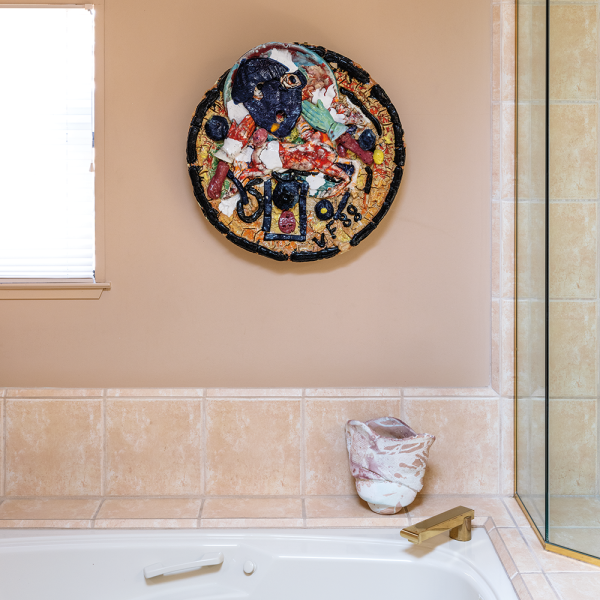
Viola Frey's Mask & Rose, 1988, glazed ceramic, 25.5 (diameter) x 4 in. (on the wall) and Paul Soldner's Untitled Vessel #36-48, ca. 1982, raku-fired earthenware, 12 x 10.5 x 5.5 in. Photo by Alanna Hale.
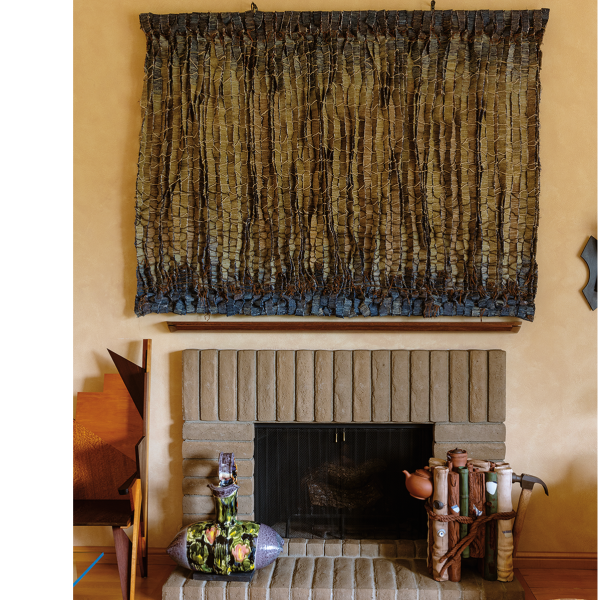
Olga de Amaral’s Riscos I (Fibra y Azul), 1983, woven wool, linen, horsehair, gesso and paint, 65 x 84 x 4 in., hangs above Betty Woodman’s Rose Pillow Pitcher, 1990, glazed earthenware, 23 x 23.25 x 14.5 in. (left) and Xiaoping Luo’s A-1 Teapot, 2004, glazed and painted ceramic, 26 x 33 x 9 in. (right) on the hearth. Side chair by Jay Stanger, 1986, aluminum, bloodwood, curly maple, pearwood, lacewood, pau amarillo, amaranth, wenge, ebony, 51 x 24.75 x 27.25 in.

In front of an unidentified tapestry is a fiddleback maple chair by Sam Maloof, 1990, 30.25 x 19.5 x 22.5 in., and a 2001 walnut end table by Tetsushi Inoue, 20 x 18 x 12 in. Photo by Alanna Hale.
While Dorothy had long been enamored with textiles, their fiber collection was jump-started when she and George received a New York gallery announcement for Cranbrook-educated, Colombian-born artist Olga de Amaral. “We adored the image, so George called our good friend Jack [Lenor] Larson and asked if he’d take a look. Jack said, ‘Buy it!’” That piece [Riscos I (Fibra y Azul), 1983] still hangs over the fireplace.
Although both Saxe abodes are filled to the gills, many works have already made the transition to their forever homes in museums around the country. In fact, Dorothy considers that she and George were not so much collectors as stewards. Beneficiaries include the Toledo Museum of Art in Ohio, the Oakland Museum of California, San Francisco’s de Young Museum, to which the Saxes bequeathed 223 objects by 132 artists in 1998 (of which 105 are already on-site), and many more. It was important to them that the work primarily go to fine arts museums rather than craft-centric institutions, as a direct response to the balkanization of studio craft by the art world at that time.
“George and Dorothy were absolutely instrumental in shining a light and helping to erase the ridiculous and arbitrary distinctions between art and craft that were then so prevalent,” affirms de Young curator Timothy Anglin Burgard, who met the Saxes in 1996 and wrote the book accompanying the 1999 exhibition—The Art of Craft: Contemporary Works from the Saxe Collection. “And they played a vital role by visiting studios, offering encouragement, and supporting the infrastructure by purchasing through galleries.”
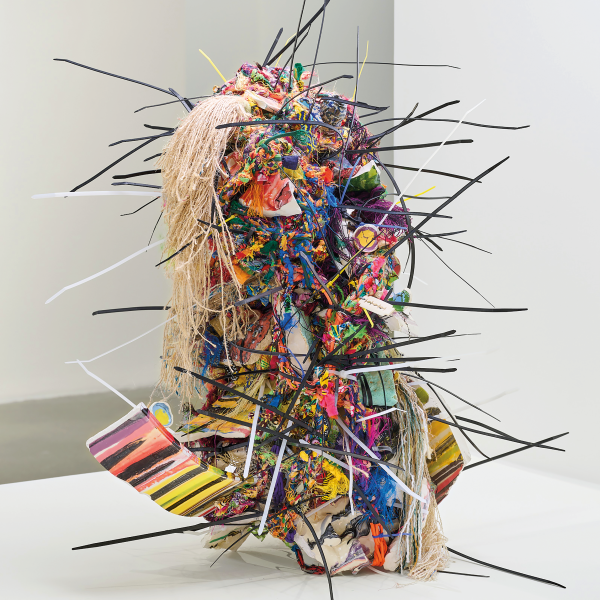
Ramekon O’Arwisters, Flowered Thorns #13 2021–2022, 2021, fabric, rope, ceramics from CSU Long Beach Ceramics Program, plastic, jewelry , 27 x 18 x 18 in. Photo by Impart Photography, courtesy of the artist and the Patricia Sweetow Gallery, San Francisco.
Dorothy acquired the Farrow pieces at two of the Contemporary Jewish Museum’s Dorothy Saxe Invitationals, an endeavor she supports that asks artists to explore a Jewish object or concept within the context of their artistic practice. “The Invitational combines two of my greatest passions: I love Judaism and I love art,” says Dorothy. (Although Farrow is Jewish, many of the artists are not.) Over the years, themes have ranged from Judaica such as seder plates and Tzedakah boxes to such open-ended concepts as Sabbath and the latest iteration: Tikkun Olam—or reparation. “It was so timely and provocative—the best one yet,” says Dorothy.
Among the 30 works at the most recent Invitational were a Lava Thomas cracked mirror repaired with kintsugi-like gold leaf (Gilded Fracture, 2022); a Ramekon O’Arwisters assemblage of fabric, jewelry, and ceramic shards (Flowered Thorns #13 2021–22, 2021); and No one is listening to us (2022), an installation by Tosha Stimage that depicts flora indigenous to Israel and Palestine and includes a Palestinian flag. “Tikkun refers to repairing something that is broken, and we leave it to the artists to interpret that however they see fit,” affirms Dorothy, when asked about potential controversy. “The museum and I hold firm in that belief, and I can’t wait to see what the next theme brings.”
Although she continues to attend galleries, studios, and fairs, and recently joined a new group of glass enthusiasts, Dorothy claims her collecting days are over. “I can’t decide if that makes me happy or disappointed,” she allows. “There are so many new artists making extraordinary work—and I’m aware that our collection is in some ways dated. But I’m 97! If I buy something now, how much longer am I going to enjoy it?”
Most of the works have already been earmarked for institutions, save for a few pieces selected by family. “I think George and I may have been most impactful as pioneers—both in the collecting and the gifting to museums,” says Dorothy. “Of course, they probably didn’t realize they’d have to wait quite so long for the rest of it. It’s sure been a hell of a fun ride.”

This article was made possible with support from the Windgate Charitable Foundation.


